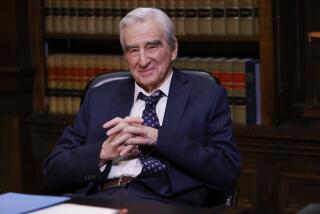A long and sober look at Prohibition history
- Share via
It’s fall on PBS, when the big documentary blockbusters heave into view; and nobody builds them bigger than Ken Burns, whose name always seems to be part of the title, even when it isn’t: “Ken Burns’ Baseball,” “Ken Burns’ Jazz,” “Ken Burns’ Civil War.” Burns likes to swallow huge subjects whole -- American subjects -- and this year he brings us “Prohibition,” the story of the 14-year misrule of the 18th Amendment and of the decades-long temperance movement that preceded it.
It’s a great subject with many present-day echoes, as the war on drugs ever more loudly raises questions of legislated morality, missed tax revenues and business opportunities created for bad people. As television, it also dovetails, historically, with “Boardwalk Empire,” whose second season has just begun and, analogously, with “Breaking Bad,” which is, after all, the story of a bootlegger.
With co-director Lynn Novick, his collaborator on “The War,” Burns tells his story in three chapters, “A Nation of Drunkards,” “A Nation of Scofflaws” and “A Nation of Hypocrites,” locally airing Sunday through Tuesday on PBS SoCal/KOCE. At more than five hours, “Prohibition,” while interesting from moment to moment, is longer than it needs to be, and made even longer by Burns’ habitual stateliness. (It’s easy to imagine him telling narrator Peter Coyote to “take that line just a little slower.”)
I prefer this approach to the machine-gun pacing of many modern documentaries, but it doesn’t fit every subject well -- “Baseball,” yes, “Jazz,” no -- and, as it often does here, can make the material feel remotely historical instead of bringing it to life. (It can also squeeze the humor from his texts.) And though, as the best-known documentary filmmaker of his time, Burns has the prestige and the resources to acquire a remarkable wealth of visual material, it does not necessarily help his story to use it all.
Prohibition did not begin on a whim, certainly: We learn that by 1830 “the average American over 15 drank the equivalent of 88 bottles of whiskey a year” -- you can see how that might lead to a temperance movement. It was in many ways a progressive movement, tied to female suffrage, even as it was a movement that also demonized immigrants, their cultures and drinking habits. But the Volstead Act, the instrument that transformed the 18th Amendment from a general ban into particular law -- “a law that would imprison Jesus if he turned water into wine,” in the words of talking head Pete Hamill -- was to be finally not an instrument of sobriety but the starting gun for a national binge that lasted from January 1920 until December 1933, when the 21st Amendment voided the 18th. By one count there were some 32,000 speakeasies operating in New York City at the height of Prohibition; the word “scofflaw” was coined to describe their innumerable patrons.
As usual, Burns uses individual case histories to tell his tale. Here is Carrie Nation with her ax, busting up saloons. There is Al Capone with his bulletproof Cadillac, a “Prohibition businessman” signing autographs and gracing the cover of Time. “I got nothing against the honest cop on the beat,” he said. “You just have them transferred someplace they can’t do you any harm.” In reality, Capone’s Chicago was, as even Lucky Luciano, visiting from New York, described it, “a crazy place. Nobody’s safe in the street.”
The drama might flag or grow diffuse, but there is still a lot here to learn. Of the talking heads, the most consistently valuable resources are Hamill and Daniel Okrent, who was also featured in “Baseball” and whose 2010 book “Last Call: The Rise and Fall of Prohibition” would seem to be the rock on which “Prohibition” is built.
Despite the presence of a few witnesses old enough to recall the time, “Prohibition” lacks a voice as vibrant as that of Shelby Foote in “The Civil War” or Buck O’Neil in “Baseball,” or the reminiscing soldiers and sailors of “The War.” It remains for Coyote’s measured narration, written by frequent Burns collaborator Geoffrey C. Ward, to push the narrative through expanses of black and white photos and footage, relieved by the occasional new glamour shot of a drink being poured. That looks pretty good, you might think, and are meant to.
--
--
‘Prohibition’
Where: KOCE
When: Part 1, 8 and 9:45 p.m. Sunday; Part 2, 8 and 10 p.m. Monday; Part 3, 8 and 10 p.m. Tuesday.
Rating: TV-PG (may be unsuitable for young children)
More to Read
The complete guide to home viewing
Get Screen Gab for everything about the TV shows and streaming movies everyone’s talking about.
You may occasionally receive promotional content from the Los Angeles Times.







